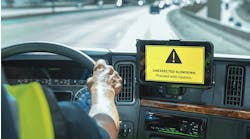When fleet owners, maintenance professionals and others in the trucking industry have the opportunity to hear Chris Reynolds talk about safety systems, they’d be smart to listen. For they not only would very likely learn from the Southeastern Freight Lines (SEFL) director of safety and security, but could also implement his ideas for their own companies.
Many hundreds of people paid rapt attention during the safety systems seminar at the recent annual meeting of the Technology & Maintenance Council (TMC) in Atlanta, as senior-level industry executives presented statistics, information and viewpoints on this crucial topic. This is Part 2 in a continuing series.
“If a picture’s worth a thousand words, then what’s video worth? It’s priceless in a lot of these instances,” said Reynolds about having no-doubt proof of what happened to cause an accident. “Video equals the most accurate witness.”
Video was what Reynolds primarily stressed in his presentation, using actual footage of some very scary ‘events’ to hammer home his points.
“Without video you just don’t have the best level of accountability,” he continued. “What would happen in an accident if there were no witnesses in a red light/green light scenario? Drivers face this every day. No witness. It becomes ‘I had the green light, he had the red light.’ If there are severe injuries what does that end up being in a litigation case? A lot of dollars. It only takes one of these to pay for a (safety) system.”
SEFL’s own statistics prove the point. In 2018 the fleet had a 2.61 accident rate per million miles on trucks without safety technology. On trucks with it? A 1.05 rate per million miles. Those numbers speak for themselves. Reynolds and SEFL, based in Lexington, SC, are in lockstep wanting all the company’s trucks to have the best equipment. Reynolds, who has been with the company for 33 years, leads a staff of six regional safety managers and 18 field safety supervisors, and is responsible for the safety programs that support 90 service centers and over 8,700 associates.
He posed a question to the audience about where their companies were at technology-wise. “Are you at a full implementation of a safety system, with cameras, with telematics, and with follow-up?” he asked. “The technology is great but without a robust follow-up system it’s only going to be sustained at a certain level. Because people will revert back to old behavior if there is no follow-up.
“We have partial implementation. Are you still gathering data and trying to select vendors? Are you testing equipment? Or are you just kind of frozen, waiting… the information overload scenario.”
Reynolds explained that there is no better time than right now for fleets to get moving on installing safety systems on their trucks.
“Let’s look at justification and implementation,” he said. “If you’re not doing anything, do something. Do a test. We started in 2014 with a test, with 10 sleepers. We liked what we saw. You have to figure out what fits your organization. Are you over-the-road line haul only? Local? Pick-up and delivery? Are you going to purchase all new equipment? Retrofit old equipment? What is the ROI?
“And what hat are you wearing? Are you wearing the fleet service hat, the operations hat, safety hat, legal, maybe HR, maybe all of the above? This is a process that encompasses every department of your organization. Because if only one department is fully engaged and fully involved it will not be successful to the level that it can be.”
One of the difficult things for fleets to do is to convince their drivers that the safety systems in place are worthy. Drivers can consider them nuisances in some regards, with the beeps alerting them to excessive speed or missed road signs, telematics recording hard braking and video showing the truck in motion all the time.
Reynolds noted that one single episode where the driver needed proof they did nothing wrong converted them to the technology forever.
“Drivers come up with excuses or reasons why they don’t need it but as soon as they have an event that’s captured on video that saves them they are then your lead spokesman why they like the system,” he said. “They become believers quickly. And some of the hardcore ones… we say would you buy it for your family? They say yes, and we say that’s why we’re buying it for you.
“I can’t emphasize that enough. Let drivers know that your company cares about them, the motoring public and safety. That this is the type of equipment we’re going to keep purchasing and implementing.”
Reynolds sounded a bit like a college professor when he invoked the Hawthorne effect into his lecture. That is a type of reactivity in which individuals modify an aspect of their behavior in response to their awareness of being observed. For truckers it equates to them being more likely to follow the rules of the road knowing video and telematics are tracking their behavior.
Keeping everything in perspective when it comes to what SEFL checks regularly is also important, as drivers shouldn’t be worried about every little thing they do.
“With the telematics you can actually see, depending on what system you have, what’s happening, what the driver is doing, what’s the RPM, what’s his braking force, does he have cruise control on, does he have a distance alert,” said Reynolds. “All of those things help you determine the root cause of what’s going on when there is (an accident). There’s so much telematics information that’s given. If you have thousands of trucks and thousands of ‘hard brakes’ a week, are all hard brakes bad? Absolutely not. That’s why you need the video for the hard brakes. Because if you try to chase every hard brake, you’ll have to open up a new department.
“Speed and distance are the two factors that create severe accidents. We like to take portal information gathered and track drivers over time. You don’t have to track down every driver and every telematics event. Does every driver that works for your company always do the right thing? No. They have bad habits sometimes. Telematics provides coaching opportunities for that. These systems, they don’t just plug and play and are maintenance-free. There’s a lot of follow-up. You have to be involved on all levels.”



